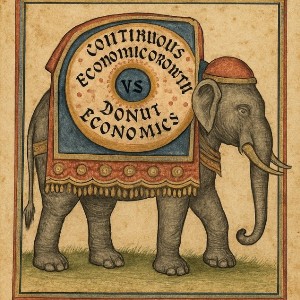Questioning Continuous Growth, Donut Economics,
and the Service Economy Transition
Leading Sustainability and Regeneration in Projects
SERIES ARTICLE
By Dr. Hugo Minney
United Kingdom

Figure 1 The elephant in the room – how do we measure success
Abstract
We confront a critical assumption in modern project mandates: the nature of “growth”. We question whether continuous GDP growth is viable or desirable on a finite planet, and conversely, challenge the notion that economic growth is inherently impossible. The article illustrates how traditional growth models have contributed to environmental degradation and social inequality. We explore alternative frameworks such as Kate Raworth’s Doughnut Economics and measurements of quality of life such as the Happiness Index and discuss the transition to a service-based economy and the emergence of the Pollution Halo Effect as viable pathways to growth which sidestep the busted GDP growth paradigm. By provoking critical thinking about the ultimate purpose of projects beyond mere financial returns, this article aims to equip project professionals and executives with a philosophical underpinning for genuinely sustainable and regenerative endeavours, and the opportunity to follow our passion as we deliver projects. Subsequent articles in the series will transform the philosophy into practical application.
Keywords: Economic Growth, Sustainability, Regeneration, Doughnut Economics, Service Economy, Project Management, Project Success Metrics, Environmental Impact, Social Inequality, Happiness Index.
Redefining prosperity beyond endless expansion
As business and project professionals, we assume that continuous economic growth, measured by Gross Domestic Product (GDP), is not only desirable but essential. The pursuit of ‘more money’ has driven vast infrastructure developments, ego projects and wasteful consumption of unsatisfying consumer goods. And yet many of our great successes were not driven by the profit motive (the ‘Sagrada Familia’ in Barcelona, the ‘Pitman’s Parliament’ in Durham are just two examples of the “built by public subscription” model).
Climate change (droughts and floods rendering new regions uninhabitable for parts of a year, winds and wildfires), wars (Ukraine, the Middle East), inequality (poverty in rich countries) and mental illness (1 in 6 adults in UK [1]) highlight the need for sustainability and regeneration; the “elephant in the room” that needs addressing is to ask what truly constitutes “growth”, and what should be our criteria for pursuing it[1]?
This series of articles is deliberately evidence-heavy, providing the foundation for shorter, practice-focused blogs which can refer back to the evidence here. In the previous two articles in this series, we challenged project managers to lead sustainability and regeneration (to “follow our passion”) [2] and proposed a holistic four-pillar approach to sustainability for projects as opposed to the various other models for general economics [3]. Now, we challenge two opposing views: that GDP growth is the only solution, and that GDP growth is impossible on a finite planet. We accept that projects are supposed to improve our quality of life, and ask how we can square continuous growth with a thriving planet and flourishing societies?
This means asking not only what projects are sustainable in their outcomes but also sustainable in their operation. We believe the key to a long and satisfying life – reflected in indices like Bhutan’s Gross National Happiness [4] or the European Social Progress Index [5] – lies in purpose: feeling part of society, feeling that we are making a difference. Therefore, a project manager delivering something that genuinely contributes and doesn’t destroy is likely to have a better quality of life than one just following orders.
More…
To read entire report, click here
Editor’s note: The author Dr. Hugo Minney is a Fellow of APM (Association for Project Management), a Member of PMI and PMI UK, Co-Chair of APM’s Benefits and Value SIG, and committee member of PMI UK’s Sustainability Community of Action. For more, see his author profile at the end of this article.
How to cite this work: Minney, H. (2025). The Elephant in the Room: Questioning Continuous Growth, Donut Economics, and the Service Economy Transition, Leading Sustainability and Regeneration in Projects, series article, PM World Journal, Volume XIV, Issue IX, September. Available online at https://pmworldlibrary.net/wp-content/uploads/2025/09/pmwj156-Sep2025-Minney-Sustainability-3-Elephant-in-the-Room.pdf
About the Author

Dr Hugo Minney
London, UK
![]()
Dr. Hugo Minney is a Fellow of APM (Association for Project Management), a Member of PMI and PMI UK, Co-Chair of APM’s Benefits and Value SIG and committee member of PMI UK’s Sustainability Community of Action (none of which are paid).
Minney set out to become a farmer but was defeated by bureaucracy. He sold high ticket computer systems and specialist software for workforce planning; joined the National Health Service for 18 years (and as a Chief Executive for the last 7 of these) and is now a project management consultant with a sideline chairing a charity restoring the sense of community for young people.
Minney works in project management, and in particular benefits management, motivating team members by reporting what they are achieving together and changing the community and culture to want to achieve – together. At present, he’s more involved on the governance side, accredited as a Social Value practitioner and Chartered Project Professional, and reviewing the balance of projects and contribution to objectives and benefits across portfolios.
Dr. Minney can be contacted at hugo.minney@thesocialreturnco.org
To view previous works by Hugo Minney, visit his author showcase in the PM World Library at https://pmworldlibrary.net/authors/dr-hugo-minney/
[1] The question “should we pursue growth at all?” is also addressed.









